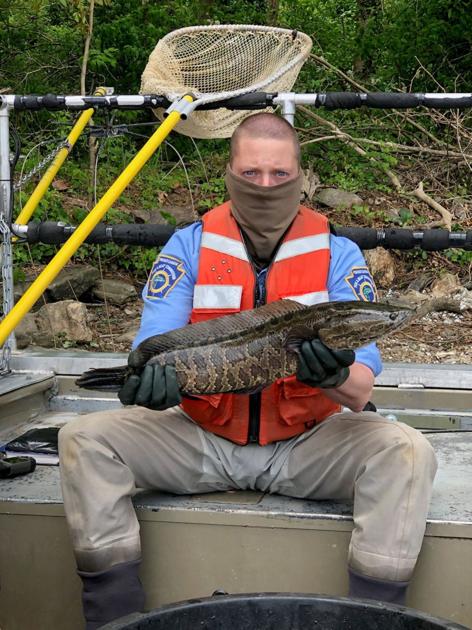Venesky: Careful what you wish for with snakeheads - Wilkes-Barre Citizens Voice

Be careful what you wish for.
Since the invasive Northern snakehead first appeared in Pennsylvania in 2004, the predatory fish has, surprisingly, been well-received by some anglers.
Even though the invasive fish can wreak havoc on an ecosystem, some anglers like the fact that they’re here because, well, they’re fun to catch.
That’s unsettling.
Snakeheads are aggressive fish with a mouth full of razor sharp teeth and a head larger in proportion to its body, which means it can consume a prey species of all sizes.
Snakeheads are native to China, and the Pennsylvania Fish and Boat Commission believes they’re present in the lower Schuylkill and Delaware rivers. The invasive fish recently turned up in the lower Susquehanna this spring as well.
That’s bad news, and it’s even more concerning that some are heralding the arrival of the snakehead for the simple reason that they’re fun to catch.
While a snakehead can smash a topwater lure with a vengeance and put up a wicked fight, that shouldn’t justify their presence.
The truth is, snakeheads can cause significant harm to our native populations of fish and amphibians. That’s why the snakehead isn’t non-native, it’s invasive, and there’s a difference.
According to the PFBC, an invasive species is one that “takes over or dominates a habit.” In addition, biologists deem an invasive species as one that causes economic or ecological harm. It’s possible snakeheads in Pennsylvania can do both.
Once established, snakeheads can outcompete native predator fish such as smallmouth bass. They can out-eat and out-proliferate smallmouths, and it could cause the latter to diminish in numbers. If snakeheads do establish in the Susquehanna and cause smallmouths to decline, that would result in an economic impact to the angling industry.
Yet from an ecological standpoint, the impact could be more sudden. Snakeheads grow at a rapid pace, and that means they need to constantly eat. Yellow perch and bluegill are tops on their menu, and according to the Maryland Department of Natural Resources, snakeheads can cause declines in prey populations.
Maryland has battled snakeheads since they invaded in 2002. Back then, a resident released two snakeheads into a Maryland pond after they outgrew his aquarium, thinking they would be safe.
Turns out, nothing was safe from the snakeheads.
As the pair of snakeheads spawned and produced young, Maryland DNR officials were so concerned about their presence that drastic measures were taken to eradicate the fish.
The state poisoned the pond to get rid of the snakeheads.
That should tell you something.
If a state wildlife agency is so worried about a particular species that they will actually spray poison — in this case, rotenone — and kill all aquatic life just to get rid of snakeheads, why would anyone want them here?
Because they’re “fun to catch?”
Fortunately, such short-sighted logic hasn’t swayed the PFBC from its mission to stave off the spread of snakeheads in the state. The agency is asking anglers to kill any snakeheads that are caught in the lower Susquehanna, and let them know about it.
It’s a good move, and the agency should expand the request for anglers to kill snakeheads caught anywhere in the state, not just the lower Susquehanna.
The PFBC also needs to continuously inform the public why snakeheads shouldn’t be here. If they don’t drive that message home, the popularity of the fish among anglers could lead to its expansion in other parts of the state.
It’s happened before.
The invasive flathead catfish, which is native to the western part of the state, has expanded throughout the eastern half of Pennsylvania. Flatheads can be enormous, weighing more than 40 pounds, they fight hard and have a voracious appetite. Because of their size and willingness to strike, flatheads became popular with anglers and, according to research conducted by Penn State, the main cause of their expansion is through intentional releases into new watersheds.
The same issue could arise with snakeheads in Pennsylvania if the fish becomes popular with anglers.
Such an occurrence could be devastating for native fish species and the ecosystem in general. Those who are accepting of snakeheads because they’re fun to catch are taking a selfish stance — putting their own interests above what’s best for Pennsylvania’s native aquatic life. Are we really willing to risk populations of smallmouths, perch and bluegills for snakeheads because they’re fun to catch?
Sure, snakeheads offer a thrill when they smash a topwater lure, but guess what else can strike a bait with a vengeance?
Smallmouth bass.
When it comes to fishing, we need to be happy with the variety of native species we have in Pennsylvania and what they offer. Fishing in Pennsylvania is just fine without snakeheads, but it might not stay that way is the invasive fish is allowed to spread.
https://ift.tt/3h788e6


Comments
Post a Comment